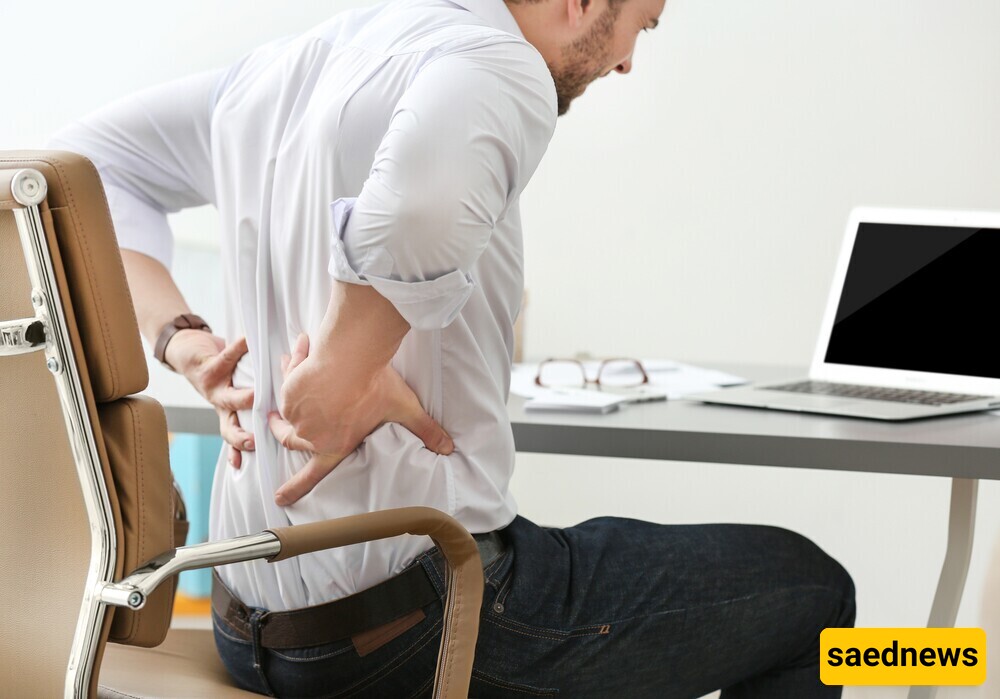SAEDNEWS: How many hours a day do you spend sitting? If your answer is more than 5 or 6 hours, you are at risk of developing chronic back, neck, and knee pain. By increasing your awareness of the effects of prolonged sitting, you can take steps to maintain your health.

According to SaedNews, how many hours a day do you spend sitting? If your answer is more than 5 or 6 hours, you are at risk of developing chronic back, neck, and knee pain. Prolonged sitting affects the health of vital organs such as the heart, lungs, and digestive system. Muscle weakness is one of the most common consequences of prolonged sitting, impacting physical strength, body shape, and overall physical health. This article reviews the effects of prolonged sitting. By increasing your awareness, you can take steps to maintain your health.
Varicose Veins and Blood Clots in the Legs: Lack of movement, excessive sitting, and prolonged standing can lead to blood pooling in the leg veins, resulting in blood clots. Varicose veins are a condition that can develop from long periods of sitting. When you sit, blood flow to the veins slows down and accumulates.
Digestive Issues: Physical activity influences the speed of digestion. To prevent digestive disorders, consider the impact of your activity level. Many people spend 8 hours a day sitting at work, which can lead to digestive and urinary problems such as constipation and stomach pain. To improve digestion and prevent digestive disorders, schedule standing, walking, or short exercises during work hours.
Increased Neck and Back Muscle Tension: Sitting for long periods can put significant pressure on the spine and neck vertebrae. Over time, without lifestyle changes, the spine loses flexibility, leading to herniated discs. This type of back pain can also result from lifting heavy objects, impacts, and other factors like prolonged inactivity. High pressure on the neck, back, hips, and head during sitting can cause chronic tension.
To prevent and treat back pain from prolonged sitting, exercise or use massagers like a neck massager. Exercise helps maintain muscle flexibility and increases muscle mass. Various massagers can also help relieve fatigue and improve muscle flexibility.
Increased Risk of Heart Disease: Prolonged sitting is associated with cardiovascular diseases. People who sit for long hours, such as drivers, office workers, and students, are more likely to develop heart conditions due to lower metabolism. Prolonged sitting delays the digestion of accumulated fat in the arteries, leading to cardiovascular issues.
Weight Gain: The body's metabolism changes with the level of physical activity. Reduced physical activity lowers metabolism, increasing the risk of serious physical conditions. Diabetes, high blood pressure, and reduced blood flow result from decreased metabolism. Another consequence of prolonged sitting is obesity, which affects overall health. Obesity can lead to body deformation, reduced muscle mass, diabetes, high blood pressure, and muscle tension.
Diabetes and Difficulty Controlling Blood Sugar: Prolonged sitting reduces the activity of the pancreas's islets of Langerhans, which produce insulin. As a result, muscles absorb less insulin, making it difficult to control blood sugar levels. Prolonged inactivity and sedentary behavior are major factors in developing type 2 diabetes, especially in those with a genetic predisposition.
Increasing physical activity, reducing sitting time, and losing weight are the first recommendations for managing or preventing diabetes. If you are at risk of diabetes, avoid prolonged sitting. Simple stretching exercises, standing, and walking between periods of sitting can help control or prevent diabetes.
Muscle Weakness: The muscles in the lower and middle body are most affected by prolonged sitting. Muscle weakness leads to poor body shape, reduced physical ability, and overall health decline. Weak leg muscles have a particularly negative impact on body stability. The muscles in the buttocks are also weakened by prolonged sitting. Inactivity causes the front thigh muscles to shorten, reducing the range of motion. Stretching, standing to improve blood circulation, and using a massager at home can help treat this condition.
Poor Posture: Weakening of the muscles that support the spine disrupts spinal balance. Shortened and weakened muscles contribute to poor posture. When sitting, the body leans forward, weakening the shoulder and back muscles, altering their standard shape. This leads to spinal misalignment and shoulder rounding from prolonged sitting. Over time, continued inactivity and prolonged sitting can cause serious conditions like sciatica or herniated discs due to spinal misalignment.
Preventing these conditions at a young age is easy by incorporating exercise or massage therapy into your routine. Stretching helps maintain muscle shape, while exercise and massage therapy increase muscle flexibility and slow the onset of poor posture.
Slowed Brain Function and Depression: Limited physical activity affects mental health as well. Depression is a mental disorder that can afflict those who habitually sit for long periods. Studies show that people who sit for 7 hours or more daily are more likely to become depressed. Changing work and behavior patterns throughout the day can improve mental health and prevent conditions like depression.

